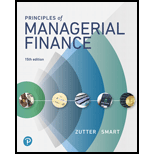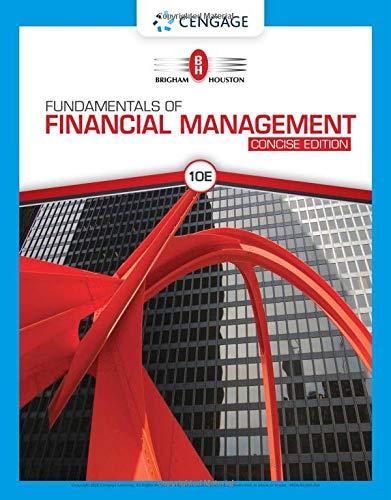
Gitman: Principl Manageri Finance_15 (15th Edition) (What's New in Finance)
15th Edition
ISBN: 9780134476315
Author: Chad J. Zutter, Scott B. Smart
Publisher: PEARSON
expand_more
expand_more
format_list_bulleted
Question
Chapter 11, Problem 11.10P
a)
Summary Introduction
To determine:
Determining the change in current assets, liabilities and Net working Capital of the firm by the new option.
Introduction:
The capital budgeting is the process of making huge investments by the firms to make their capital assets grow faster such as the building of new buildings, purchase of advanced costly machineries etc.
b)
Summary Introduction
To determine:
Why the current accounts are relevant in determining the initial investment of the proposed investment project.
c)
Summary Introduction
To determine: Whether the change in net working capital enter into any other cash flow that make up the Project's net cash flows.
Expert Solution & Answer
Want to see the full answer?
Check out a sample textbook solution
Students have asked these similar questions
Security market line (SML) Assume that the risk-free rate, RF, is currently 8% and that the market return, rm, is
currently 15%.
a. Calculate the market risk premium.
b. Given the previous data, calculate the required return on asset A having a beta of 0.8 and asset B having a beta
of 1.9.
a. The market risk premium is ☐ %. (Round to one decimal place.)
b. If the beta of asset A is 0.8, the required return for asset A is %. (Round to one decimal place.)
If the beta of asset B is 1.9, the required return for asset B is
%. (Round to one decimal place.)
Risk and probability Micro-Pub, Inc., is considering the purchase of one of two digital cameras, R and S, each of
which requires an initial investment of $4,000. Management has constructed the following table of estimates of rates of
return and probabilities for pessimistic, most likely, and optimistic results:
a. Determine the range for the rate of return for each of the two cameras.
b. Determine the value of the expected return for each camera.
c. Which camera purchase is riskier? Why?
a. The range for the rate of return for camera R is
%. (Round to the nearest whole number.)
The range for the rate of return for camera S is ☐ %. (Round to the nearest whole number.)
b. The value of the expected return for camera R is
%. (Round to two decimal places.)
The value of the expected return for camera S is %. (Round to two decimal places.)
c. Which camera purchase is riskier? Why? (Select from the drop-down menus.)
The purchase of
is riskier because it has a
range for the rate of return.
4 analysts covered the stock of Flooring Chemical. One forecasts a 5% return for the coming year. The second expects the return to be -4%. The third predicts a return of 9%. The fourth expects a 1% return in the coming year. You are relatively confident that the return will be positive but not large, so you arbitrarily assign probabilities of being correct of 33%, 7%, 18%, and 42%, respectively to the analysts' forecasts. Given these probabilities, what is Flooring Chemical's expected return for the coming year?
Chapter 11 Solutions
Gitman: Principl Manageri Finance_15 (15th Edition) (What's New in Finance)
Ch. 11.1 - Prob. 11.1RQCh. 11.1 - What three types of net cash flows may exist for a...Ch. 11.1 - Prob. 11.3RQCh. 11.1 - Prob. 11.4RQCh. 11.2 - Explain how to use each of the following inputs to...Ch. 11.2 - How do you calculate the book value of an asset?Ch. 11.2 - Prob. 11.7RQCh. 11.2 - Prob. 11.8RQCh. 11.3 - Prob. 11.9RQCh. 11.3 - Prob. 11.10RQ
Ch. 11.4 - Explain how the terminal cash flow is calculated...Ch. 11 - Book value, taxes, and initial investment Irvin...Ch. 11 - If Halley Industries reimburses employees who earn...Ch. 11 - Iridium Corp. has spent 3.5 billion over the past...Ch. 11 - Prob. 11.3WUECh. 11 - Prob. 11.4WUECh. 11 - Prob. 11.5WUECh. 11 - Prob. 11.1PCh. 11 - Net cash flow and time line depiction For each of...Ch. 11 - Replacement versus expansion cash flows Tesla...Ch. 11 - Sunk costs and opportunity costs Masters Golf...Ch. 11 - Prob. 11.5PCh. 11 - Prob. 11.6PCh. 11 - Prob. 11.7PCh. 11 - Book value and taxes on sale of assets Troy...Ch. 11 - Prob. 11.9PCh. 11 - Prob. 11.10PCh. 11 - Calculating initial investment Vastine Medical...Ch. 11 - Prob. 11.12PCh. 11 - Prob. 11.13PCh. 11 - Prob. 11.14PCh. 11 - Prob. 11.15PCh. 11 - Prob. 11.16PCh. 11 - Prob. 11.17PCh. 11 - Prob. 11.18PCh. 11 - Prob. 11.19PCh. 11 - Prob. 11.20PCh. 11 - Prob. 11.21PCh. 11 - Prob. 11.22PCh. 11 - Net cash flows for a marketing campaign Marcus...Ch. 11 - Net cash flows: No terminal value Central Laundry...Ch. 11 - Prob. 11.25PCh. 11 - Ethics Problem Cash flow projections are a central...
Knowledge Booster
Similar questions
- Why you would be a quality recipient of the Linda K Crandall Nutrition Scholarship.arrow_forwardIf Image is blurr then tell me . please comment below i will write values. if you answer with incorrect values i will give unhelpful confirm.arrow_forwardNormal probability distribution Assuming that the rates of return associated with a given asset investment are normally distributed; that the expected return, r, is 17.2%; and that the coefficient of variation, CV, is 0.86, answer the following questions: a. Find the standard deviation of returns, or. b. Calculate the range of expected return outcomes associated with the following probabilities of occurrence: (1) 68%, (2) 95%, (3) 99%. a. The standard deviation of returns, or, is %. (Round to three decimal places.) b. (1) The lowest possible expected return associated with the 68% probability of occurrence is %. (Round to two decimal places.) The highest possible expected return associated with the 68% probability of occurrence is decimal places.) (2) The lowest possible expected return associated with the 95% probability of occurrence is decimal places.) %. (Round to two %. (Round to two The highest possible expected return associated with the 95% probability of occurrence is decimal…arrow_forward
- General Finance Please don't answer i posted blurred image mistakely. please comment below i will write values. if you answer with incorrect values i will give unhelpful confirm.arrow_forwardno ai Please don't answer i posted blurred image mistakely. please comment below i will write values. if you answer with incorrect values i will give unhelpful confirm.arrow_forwardFinan Please don't answer i posted blurred image mistakely. please comment below i will write values. if you answer with incorrect values i will give unhelpful confirm.arrow_forward
- see itPlease don't answer i posted blurred image mistakely. please comment below i will write values. if you answer with incorrect values i will give unhelpful confirm.arrow_forwardNo use ai. if image is blurr or data is not showing properly then dont answer i will sure deslike. please comment i will write values.arrow_forwardDon't use ai. if image is blurr or data is not showing properly then dont answer i will sure deslike. please comment i will write values.arrow_forward
- no ai Please don't answer i posted blurred image mistakely. please comment below i will write values. if you answer with incorrect values i will give unhelpful confirm.arrow_forwardFinance SubjPlease don't answer i posted blurred image mistakely. please comment below i will write values. if you answer with incorrect values i will give unhelpful confirm.arrow_forwardcalculate ratios for the financial statment given and show all working manually: 3. TIE Ratio 4. Cash Coverage Ratioarrow_forward
arrow_back_ios
SEE MORE QUESTIONS
arrow_forward_ios
Recommended textbooks for you
 Fundamentals Of Financial Management, Concise Edi...FinanceISBN:9781337902571Author:Eugene F. Brigham, Joel F. HoustonPublisher:Cengage Learning
Fundamentals Of Financial Management, Concise Edi...FinanceISBN:9781337902571Author:Eugene F. Brigham, Joel F. HoustonPublisher:Cengage Learning Survey of Accounting (Accounting I)AccountingISBN:9781305961883Author:Carl WarrenPublisher:Cengage Learning
Survey of Accounting (Accounting I)AccountingISBN:9781305961883Author:Carl WarrenPublisher:Cengage Learning Managerial AccountingAccountingISBN:9781337912020Author:Carl Warren, Ph.d. Cma William B. TaylerPublisher:South-Western College Pub
Managerial AccountingAccountingISBN:9781337912020Author:Carl Warren, Ph.d. Cma William B. TaylerPublisher:South-Western College Pub EBK CONTEMPORARY FINANCIAL MANAGEMENTFinanceISBN:9781337514835Author:MOYERPublisher:CENGAGE LEARNING - CONSIGNMENT
EBK CONTEMPORARY FINANCIAL MANAGEMENTFinanceISBN:9781337514835Author:MOYERPublisher:CENGAGE LEARNING - CONSIGNMENT Intermediate Financial Management (MindTap Course...FinanceISBN:9781337395083Author:Eugene F. Brigham, Phillip R. DavesPublisher:Cengage Learning
Intermediate Financial Management (MindTap Course...FinanceISBN:9781337395083Author:Eugene F. Brigham, Phillip R. DavesPublisher:Cengage Learning

Fundamentals Of Financial Management, Concise Edi...
Finance
ISBN:9781337902571
Author:Eugene F. Brigham, Joel F. Houston
Publisher:Cengage Learning


Survey of Accounting (Accounting I)
Accounting
ISBN:9781305961883
Author:Carl Warren
Publisher:Cengage Learning

Managerial Accounting
Accounting
ISBN:9781337912020
Author:Carl Warren, Ph.d. Cma William B. Tayler
Publisher:South-Western College Pub

EBK CONTEMPORARY FINANCIAL MANAGEMENT
Finance
ISBN:9781337514835
Author:MOYER
Publisher:CENGAGE LEARNING - CONSIGNMENT

Intermediate Financial Management (MindTap Course...
Finance
ISBN:9781337395083
Author:Eugene F. Brigham, Phillip R. Daves
Publisher:Cengage Learning